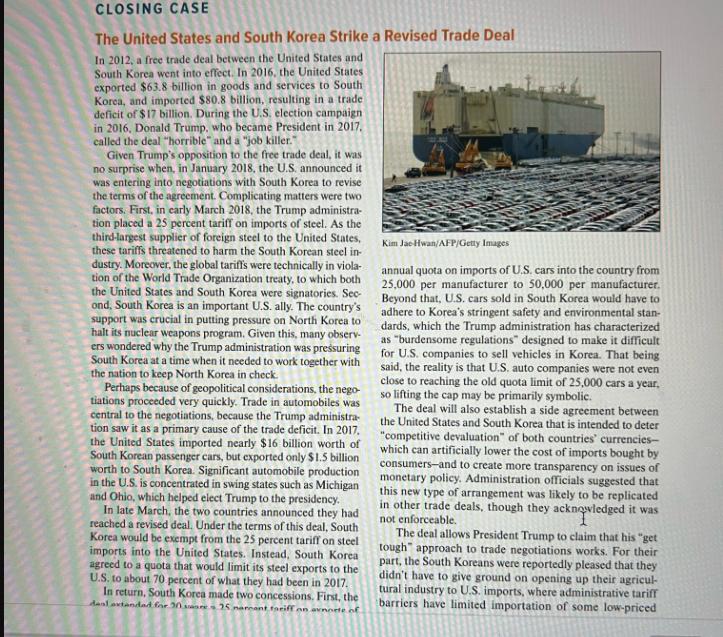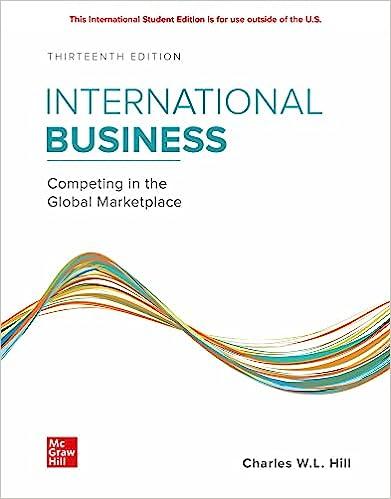Answered step by step
Verified Expert Solution
Question
1 Approved Answer
1. Why do you think the Obama administration pursued a trade deal with Korea in 2012? What were the potential economic and political benefits?


1. Why do you think the Obama administration pursued a trade deal with Korea in 2012? What were the potential economic and political benefits? What were the potential costs? 2. Is there any evidence that the 2012 free trade deal between the United States and South Korea was a "job killer" as claimed by President Trump? 3. What were the motivations of the Trump administration in renegotiating the 2012 deal? 4. Who benefits from the revised (2018) deal? Who might lose? Does the 2018 deal represent an improvement over that ratified in 2012? CLOSING CASE The United States and South Korea Strike a Revised Trade Deal In 2012, a free trade deal between the United States and South Korea went into effect. In 2016, the United States exported $63.8 billion in goods and services to South Korea, and imported $80.8 billion, resulting in a trade deficit of $17 billion. During the U.S. election campaign in 2016, Donald Trump, who became President in 2017. called the deal "horrible" and a "job killer." Given Trump's opposition to the free trade deal, it was no surprise when, in January 2018, the U.S. announced it was entering into negotiations with South Korea to revise the terms of the agreement. Complicating matters were two factors. First, in early March 2018, the Trump administra- tion placed a 25 percent tariff on imports of steel. As the third-largest supplier of foreign steel to the United States, these tariffs threatened to harm the South Korean steel in- dustry. Moreover, the global tariff's were technically in viola- tion of the World Trade Organization treaty, to which both the United States and South Korea were signatories. Sec- ond, South Korea is an important U.S. ally. The country's support was crucial in putting pressure on North Korea to halt its nuclear weapons program. Given this, many observ- ers wondered why the Trump administration was pressuring South Korea at a time when it needed to work together with the nation to keep North Korea in check. Perhaps because of geopolitical considerations, the nego tiations proceeded very quickly. Trade in automobiles was central to the negotiations, because the Trump administra tion saw it as a primary cause of the trade deficit. In 2017. the United States imported nearly $16 billion worth of South Korean passenger cars, but exported only $1.5 billion worth to South Korea. Significant automobile production in the U.S. is concentrated in swing states such as Michigan and Ohio, which helped elect Trump to the presidency. In late March, the two countries announced they had reached a revised deal. Under the terms of this deal, South Korea would be exempt from the 25 percent tariff on steel imports into the United States. Instead, South Korea agreed to a quota that would limit its steel exports to the U.S. to about 70 percent of what they had been in 2017. In return, South Korea made two concessions. First, the daal extended for 30 are 25 marcant tariff on anorte of Kim Jae-Hwan/AFP/Getty Images annual quota on imports of U.S. cars into the country from 25,000 per manufacturer to 50,000 per manufacturer. Beyond that, U.S. cars sold in South Korea would have to adhere to Korea's stringent safety and environmental stan dards, which the Trump administration has characterized as "burdensome regulations" designed to make it difficult for U.S. companies to sell vehicles in Korea. That being said, the reality is that U.S. auto companies were not even close to reaching the old quota limit of 25,000 cars a year, so lifting the cap may be primarily symbolic. The deal will also establish a side agreement between the United States and South Korea that is intended to deter "competitive devaluation" of both countries' currencies- which can artificially lower the cost of imports bought by consumers-and to create more transparency on issues of monetary policy. Administration officials suggested that this new type of arrangement was likely to be replicated in other trade deals, though they acknowledged it was not enforceable. The deal allows President Trump to claim that his "get tough approach to trade negotiations works. For their part, the South Koreans were reportedly pleased that they didn't have to give ground on opening up their agricul tural industry to U.S. imports, where administrative tariff barriers have limited importation of some low-priced
Step by Step Solution
There are 3 Steps involved in it
Step: 1

Get Instant Access to Expert-Tailored Solutions
See step-by-step solutions with expert insights and AI powered tools for academic success
Step: 2

Step: 3

Ace Your Homework with AI
Get the answers you need in no time with our AI-driven, step-by-step assistance
Get Started


